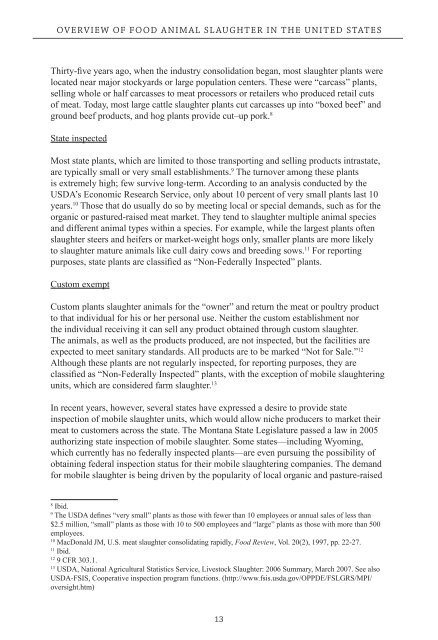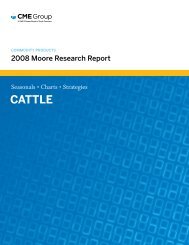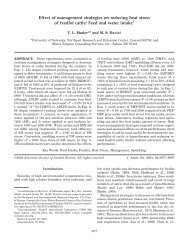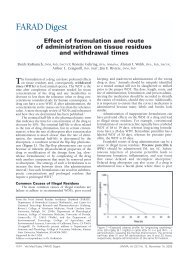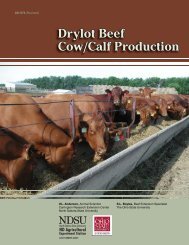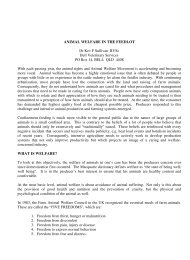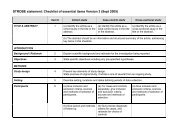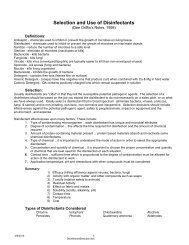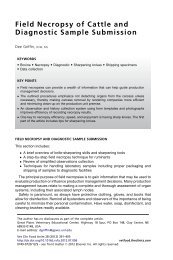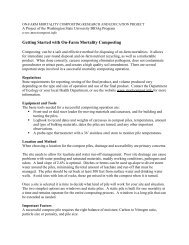CRIMES WITHOUT CONSEQUENCES - gpvec
CRIMES WITHOUT CONSEQUENCES - gpvec
CRIMES WITHOUT CONSEQUENCES - gpvec
You also want an ePaper? Increase the reach of your titles
YUMPU automatically turns print PDFs into web optimized ePapers that Google loves.
overvieW of food animal slaughter in the united states<br />
Thirty-five years ago, when the industry consolidation began, most slaughter plants were<br />
located near major stockyards or large population centers. These were “carcass” plants,<br />
selling whole or half carcasses to meat processors or retailers who produced retail cuts<br />
of meat. Today, most large cattle slaughter plants cut carcasses up into “boxed beef” and<br />
ground beef products, and hog plants provide cut–up pork. 8<br />
State inspected<br />
Most state plants, which are limited to those transporting and selling products intrastate,<br />
are typically small or very small establishments. 9 The turnover among these plants<br />
is extremely high; few survive long-term. According to an analysis conducted by the<br />
USDA’s Economic Research Service, only about 10 percent of very small plants last 10<br />
years. 10 Those that do usually do so by meeting local or special demands, such as for the<br />
organic or pastured-raised meat market. They tend to slaughter multiple animal species<br />
and different animal types within a species. For example, while the largest plants often<br />
slaughter steers and heifers or market-weight hogs only, smaller plants are more likely<br />
to slaughter mature animals like cull dairy cows and breeding sows. 11 For reporting<br />
purposes, state plants are classified as “Non-Federally Inspected” plants.<br />
Custom exempt<br />
Custom plants slaughter animals for the “owner” and return the meat or poultry product<br />
to that individual for his or her personal use. Neither the custom establishment nor<br />
the individual receiving it can sell any product obtained through custom slaughter.<br />
The animals, as well as the products produced, are not inspected, but the facilities are<br />
expected to meet sanitary standards. All products are to be marked “Not for Sale.” 12<br />
Although these plants are not regularly inspected, for reporting purposes, they are<br />
classified as “Non-Federally Inspected” plants, with the exception of mobile slaughtering<br />
units, which are considered farm slaughter. 13<br />
In recent years, however, several states have expressed a desire to provide state<br />
inspection of mobile slaughter units, which would allow niche producers to market their<br />
meat to customers across the state. The Montana State Legislature passed a law in 2005<br />
authorizing state inspection of mobile slaughter. Some states—including Wyoming,<br />
which currently has no federally inspected plants—are even pursuing the possibility of<br />
obtaining federal inspection status for their mobile slaughtering companies. The demand<br />
for mobile slaughter is being driven by the popularity of local organic and pasture-raised<br />
8 Ibid.<br />
9 The USDA defines “very small” plants as those with fewer than 10 employees or annual sales of less than<br />
$2.5 million, “small” plants as those with 10 to 500 employees and “large” plants as those with more than 500<br />
employees.<br />
10 MacDonald JM, U.S. meat slaughter consolidating rapidly, Food Review, Vol. 20(2), 1997, pp. 22-27.<br />
11 Ibid.<br />
12 9 CFR 303.1.<br />
13 USDA, National Agricultural Statistics Service, Livestock Slaughter: 2006 Summary, March 2007. See also<br />
USDA-FSIS, Cooperative inspection program functions. (http://www.fsis.usda.gov/OPPDE/FSLGRS/MPI/<br />
oversight.htm)<br />
13


